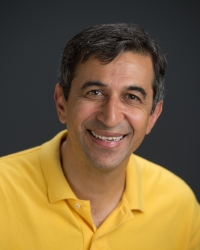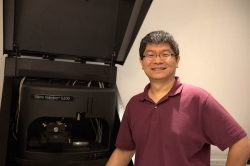Engineering Faculty Contribute Brain Power to Head Injury Research

Assistant Professor Edmond J. Dougherty ’69 EE, ’86 MSCS
A number of Villanova University faculty members are putting their minds to work on head injuries. From student and professional athletes, to military personnel and the elderly, conditions affecting the brain—and how to diagnose them—are of increasing interest to researchers around the globe. In the College of Engineering, professors across disciplines are pursuing independent, yet interconnected projects related to brain impact and injuries.
Monitoring Effects of Multiple Impacts
In the Department of Electrical and Computer Engineering, Assistant Professor Edmond J. Dougherty ’69 EE, ’86 MSCS, director of the College’s Engineering Entrepreneurship program, is on his fourth prototype for BandaVida. Currently a six-inch, one-ounce strip designed to be worn in a headband, the device electronically monitors the direction, duration and magnitude of impacts and vibrations to the head over time. It can store up to 30 years of data. As Dougherty explains: “While we all know that a large impact to a person’s head will cause a concussion, only recently has the medical community realized the seriousness of smaller repetitive impacts over time and the effect multiple concussions can have on the health of a person. Such head impacts can lead to long term neurological problems that can greatly affect a person’s quality of life.”

Professor Hashem Ashrafiuon, PhD, director of the Center for Nonlinear Dynamics and Control
Instant Diagnoses
Three Villanova Mechanical Engineering faculty members also are engaged in studies specific to brain impact and diagnosis. Professor Hashem Ashrafiuon, PhD, director of the Center for Nonlinear Dynamics and Control, is considering the viability of electroencephalography (EEG) for instantly diagnosing concussions. Having developed EEG technology using single electrode devices, his work is being used in sports helmets that can instantly diagnose concussions by detecting significant changes in brain waves that occur immediately after impact.
Dr. Ashrafiuon sees many applications for this technology, including the detection of Alzheimer’s disease. In a separate study, a portable activated EEG device has been introduced for the physiological assessment of brain health and responsiveness to therapy. Data is being collected from healthy adults and those with Alzheimer’s in order to predict and quantify abnormalities in brain function.

Associate Professor Gang Feng, PhD
A great deal of media coverage has been given to research that Associate Professor Gang Feng, PhD, conducted with Shu Yang, PhD, a professor in the University of Pennsylvania’s School of Engineering and Applied Science. In collaboration with researchers from Temple University, the team has developed a polymer-based material that changes colors depending on how hard it is hit. The goal is to incorporate this material into protective headgear that could give an early warning sign of a concussion, thereby addressing the issue of long-term complications stemming from past head trauma.

Associate Professor Qianhong Wu, PhD
Director and founder of Villanova’s Cellular Biomechanics and Sport Science Laboratory, Associate Professor Qianhong Wu, PhD, is engaged in a number of studies related to the functioning of the human body. Among his current projects is a smart brain model to study the intrinsic brain damage inside of the skull subjected to the impact of head collision. “It enables us to identify the internal concussion mechanisms of the brain during the impact moment. Furthermore, if the smart brain is incorporated with the neuroscience sensors, there will be great potential to use it to solve the mystery of how the brain neuro-system is affected by the impact over a period of time,” explains Dr. Wu. The obvious benefit of a smart brain model is that it can be subjected to repeated tests that simulate—in a laboratory environment—what is happening on the the field.
This multi-disciplinary project integrates computational, theoretical and experimental approaches and involves the fields of fluid mechanics—one of Dr. Wu’s specialties—and materials science. Bringing his materials science expertise to the research is Mechanical Engineering Associate Professor Kei-Peng Jen, PhD. Also involved in the project is senior Marissa Cucinotta ’16 ME, a Villanova University Presidential Scholar. Marissa currently is a finalist for the highly prestigious Marshall Scholarship and plans to pursue graduate study in the field of biomedical engineering.
A College-wide Interest in Human Health
Beyond brain injuries, faculty and students in the College of Engineering are engaged in a variety of research projects related to medicine, healthcare, and quality of life. Over the past three years, studies have included the cryopreservation of living tissue, data analytics to improve medical diagnoses, development of customizable tumor-targeting nanoparticles, advances in gene therapy, analysis of bone material composition, use of biomaterials for drug delivery applications, and more. Drosdick Endowed Dean of Engineering Gary A. Gabriele, PhD, looks forward to what lies ahead: “Our faculty are making impressive strides in many areas related to human health and well-being, and what’s especially exciting is how they have involved our engineering undergraduates and graduate students in their research. I anticipate many great things to come.”
